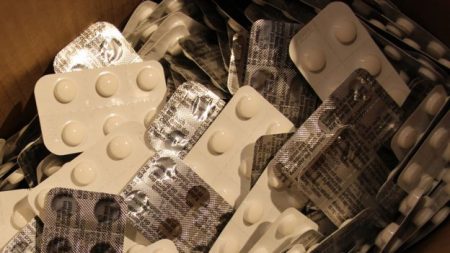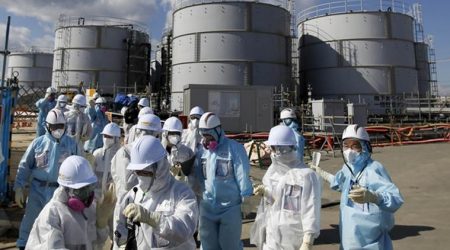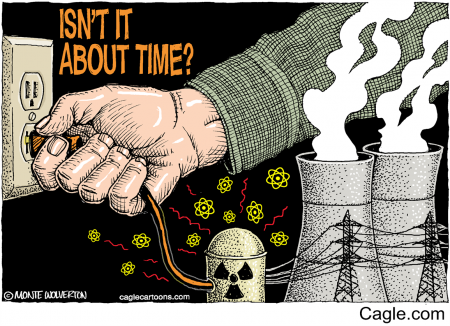September 1, 2017 – In the news today the German government announced it is issuing potassium iodide pills to citizens in Aachen, a city on the edge of the border with Belgium.
Why?
Because the Tihange 2 nuclear plant, some 70 kilometers from the German city, has reported micro-cracks in its structure. So far there are no leaks but the Germans are nervous and taking no chances. They have asked Belgium to accelerate decommissioning plans for Tihange 2 and its 6 other nuclear power plants. The current plans are for shutdowns between 2023 and 2025. Germany would like the dates to be sooner and if possible, to coincide with the country’s own shutdown deadline of 2022.

Dosages depend on age.
Older than 46 you don’t need to take a pill because the risk of cancer from radioactive iodine past that age is far less.
From age 13 to 46 the recommended dosage will be two pills initially.
Dosage for children age 3 to 12 will be one pill.
For babies and toddlers, the recommended dose will be a quarter pill.
This latest nuclear scare is just another in the history of the nuclear technology we have deployed since the dawn of the Atomic Age.

What were the mistakes?
Beginning with the Atomic Energy Commission‘s (AEC) birth in 1946, nuclear power was the positive side of the other reason for the technology, atomic bombs. Where the bombs represented an uncontrolled chain reaction, nuclear power would demonstrate the technology in chains, a slave to our energy needs. Nuclear power was to be cheap, safe and clean.
The AEC commissioned Westinghouse to build the first atomic power plant. It was to be the power source for a new submarine, the Nautilus, a submersible that could remain underwater for months without surfacing, running quietly and efficiently using the power of controlled atomic fission. The Nautilus power plant was a small form factor, not much bigger than a family closet. After the success of the Nautilus Westinghouse soon designed larger nuclear power plants for aircraft carriers, and later even a merchant ship.
But President Harry Truman‘s 1952 vision of atomic power plants running airplanes, homes, factories, and farms, was never to be realized. Instead of a furnace running on oil, coal or natural gas, visionaries imagined a basement atomic power plant, small, manageable, running on a few pellets of uranium or plutonium or some other radioactive substance. If every house had one of these there would be no need for massive nuclear plants.
But under President Eisenhower the notion of every home having its own nuclear reactor vanished. Instead, the AEC gave Westinghouse the green light to build utility-sized commercial nuclear reactors. The first, commissioned in 1957, cost more than 3 times its original estimate of $38 million. The electricity produced cost seven times more than what the Duquesne Light, the customer, actually paid.
Nuclear power at a utility scale, therefore, was a non-starter right from the beginning. But the U.S. government and other countries joining the nuclear club wanted these plants and so they got built. There were heavy-water reactors, fast breeder reactors, and many other technical designs. All had three things in common.
- The facilities were huge.
- The cost overruns were enormous and completion schedules lagged for years.
- The fuel used was fissile material suitable for making atomic and hydrogen bombs.
As Westinghouse began to scale the business, cost savings were small. Every construction site turned out to be a custom job. Plants often were delayed by the negative community response.
Government heavily subsidized the industry and continues to do so to this day. Although it continues to be seen as a clean alternative to coal-fired and natural gas power plants, it is not the case. The carbon footprint in the build and servicing of nuclear power plants makes the technology far from green. Nuclear as it is today is not a suitable climate change technology. The concrete used to build these plants as well as the infrastructure support during construction contributes enormously to greenhouse gases. And then there is the problem of dealing with spent fuel rods which remain radioactive for tens of thousands of years. There remains no safe, sustainable solution for spent fuel with the best solutions involving burying the waste costing billions of dollars.
The argument that nuclear is a clean alternative to coal-fired and natural gas power plants, is proving to stand on weak ground. The carbon footprint during the build and servicing makes these plants far from green. Nuclear today, therefore, is not a suitable climate change alternative energy technology. And when you add the problem of dealing with spent fuel rods which remain radioactive for tens of thousands of years, it is like nailing the coffin shut on the nuclear power corpse.
So the industry’s existence as it is today is really not justifiable other than to be a primary source for making radioactive elements with the biggest being bomb making materials. In a recent opinion piece that appeared in Bloomberg View, Stephen Mihm writes that nuclear “began as an idealistic attempt to domesticate the bomb in peacetime.” He continues, “the world has spent nearly sixty years trying to make economic sense of nuclear power with limited success. It may be time to pull the plug.”
There is another side to the nuclear story
If we were to dispense with the existing nuclear power models and start fresh we might have something that would be a great fit for the post-fossil fuel age. Nuclear power plants don’t have to be the massive beasts they are today. They don’t have to use fuels that cannot be recycled. If an accident occurs they don’t have to have a meltdown. Alternatives are already available that provide better and greener nuclear power solutions. Here are three.
iMSR
Back in January of 2016, I wrote about a small molten salt nuclear reactor being developed by Terrestrial Energy, a company located in Oakville, Ontario. The technology called an Integrated Molten Salt Reactor or iMSR, is based on work done at Oak Ridge National Laboratory in the United States where the first prototype iMSRs were developed in the mid-1960s. Now Terrestrial in partnership with Oak Ridge has received seed capital to proceed with building a commercial reactor.
What makes an iMSR a better, cleaner solution? The iMSR uses liquid fuel. It doesn’t require a sophisticated, pressurized containment housing to keep the fission reaction under control. Its fuel is 100% recyclable. And it’s modular so you can have one or several working in close proximity. Each self-contained power plant is designed to operate for seven years before being taken offline and having its components recycled. A single iMSR module could power a neighbourhood without being plugged into a national grid. And an iMSR would be far cheaper to build and maintain than any nuclear power plant in operation today.
Thorium Molten Salt
China, France, and India are trying to create cleaner, safer nuclear power technology by building thorium molten salt reactors (TMSR). Thorium is considered a super fuel. A TMSR will never meltdown. Its byproducts cannot be turned into nuclear bombs.
Micro nukes
NuScale, Toshiba, Hyperion Power Generation, Sandia National Labs, and TerraPower are all competing to produce small power plants designed for microgrids or even a factory. Micro nukes are characterized as being highly safe technologies. They don’t use fuel rods. Instead, the fuel is pelletized uranium, thorium, plutonium or other radioactive materials with deuterium or other liquid circulating as the coolant.
Fusion
And then there is the promise of fusion with its potential for unlimited, clean, safe power. On fusion, there have been some interesting developments since I last covered the subject. We’ll talk about those advances in a separate posting.
















